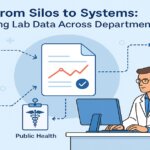
Advanced Clinical Laboratory Data Management: Uncommon Insights & Pro Tactics Using Skelab
Go beyond the basics. Explore advanced data management tactics for clinical labs using Skelab—including automation, workflow design, patient journey tracking, and compliance innovations.
Think Beyond the Dashboard: A Data-Centric Culture in the Lab
Skelab isn’t just a tool—it’s a strategic foundation for creating a data-centric culture in your lab. When properly configured, it can become the central nervous system for your operations.
But to unlock that potential, labs must look beyond daily use. Below are less common but highly effective strategies to elevate how you manage and leverage your data with Skelab.
🔍 1. Map the Full Patient Journey — Not Just the Test
While most labs focus on test results, Skelab allows you to map the entire patient journey—from intake to feedback. Tracking every interaction provides new insights into bottlenecks and drop-off points.
Pro Tip: Use timestamped logs to analyze:
- How long patients wait between stages
- Where most rescheduling or no-shows occur
- Repeat patient trends by diagnosis or test type
🧠 2. Use Behavioral Analytics to Improve Staff Performance
Few labs use Skelab’s backend logs to review team performance. You can audit:
- Who edited reports and when
- Staff handling the highest volume
- Common edit patterns that signal workflow inefficiencies
Pro Tip: Set up alerts for frequent corrections in certain tests or by certain users—it may signal training gaps or unclear SOPs.
🔁 3. Design Conditional Logic in Test Templates
With Skelab’s advanced test template logic, you can trigger specific fields to appear only when relevant (e.g., show “Fasting Hours” if blood glucose is ordered).
Pro Tip: Use logic conditions to:
- Hide unnecessary fields
- Auto-fill reference ranges by patient age/sex
- Flag critical values instantly for certain panels
📊 4. Build Data-Driven Marketing Campaigns from Test Trends
Skelab helps you segment patient data—like test frequency, conditions, or referring doctors. Use this to:
- Target reminders to patients due for annual screenings
- Offer discounted health packages to corporate clients
- Promote underutilized tests during low-volume months
Pro Tip: Export data from Skelab monthly to spot seasonal test trends and plan campaigns accordingly.
🧬 5. Use Custom Lab Profiles for Specialized Clients
Skelab allows creation of “Lab Profiles” for doctors or companies that request specific groupings or result formats.
Example:
- A cardiologist might want lipid panels grouped with ECG notes.
- A corporate client may want employee results delivered in a CSV format for wellness reporting.
Pro Tip: Save profiles and automate report formatting based on who ordered the test.
🛡️ 6. Auto-Redact Sensitive Info When Needed
Some results require restricted disclosure. With Skelab, you can configure:
- Redacted result versions for non-medical clerks
- Automatic anonymization of corporate reports
Pro Tip: Enable dual-report mode: one version for patients, another for referring physicians.
🧩 7. Use Skelab APIs to Integrate with EMRs or Insurance Platforms
Most clinics don’t realize Skelab offers API hooks for:
- Auto-pushing lab results to hospital EMRs
- Syncing insurance validation tools
- Triggering SMS/email bots via external CRM tools
Pro Tip: Set up API-based report sharing with partner hospitals or mobile apps for seamless care coordination.
Conclusion: Unleashing the Full Power of Skelab
Clinical laboratory excellence isn’t just about running tests—it’s about mastering data. Using Skelab in these unconventional ways, you can build a lab operation that is not only fast and compliant, but also intelligent, adaptive, and future-ready.
⚙️ Next Step: Customize Your Skelab Configuration
Want help setting up automation rules, smart templates, or advanced analytics in your Skelab instance?
📩 Schedule a free strategy session with a Skelab specialist and get a full audit of your current setup.





